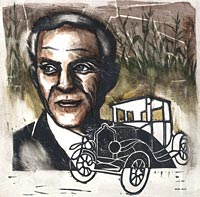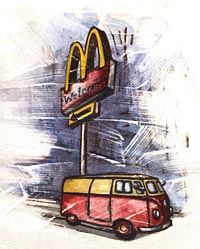The way most people talk about biofuels, you’d think they were a brand-new invention. But using natural products for fuel is an idea as old as the hills, as this highly selective timeline demonstrates.
Mid-1800s: Soap-makers begin to transesterify vegetable oils — you know, exchanging the alkoxy group of an ester compound by using another alcohol, often catalyzed by the addition of an acid or base. Ahem. Or, for you non organic chemists, breaking down one molecule and building a shiny new one. Transesterification (not to be confused with transvestite Transylvanians) produces methyl and ethyl esters, of which biodiesel will be composed in the following decades. Good, clean fun abounds.
1900: After experimenting with whale oil, the soon-to-be-famous (or at least familiar-sounding) Rudolph Diesel uses peanut oil as fuel when demonstrating his newly invented compression ignition engine at the World’s Fair in Paris.

Henry Ford and the Model T.
Illustrations: Keri Rosebraugh
1908: Soon-to-be-famous (and more than familiar-sounding) Henry Ford introduces the Model T, which runs on hemp- and corn-based ethanol. As Ford continues to design automobiles, all are built to run on ethanol. Ford builds an ethanol plant in the Midwest.
1912: In a speech, Diesel says, “The use of vegetable oils for engine fuels may seem insignificant today, but such oils may become, in the course of time, as important as petroleum and the coal-tar products of the present time.” We might be getting there, Deez.

1913: Diesel disappears mysteriously after supping on his steamboat. His body is found a few days later, floating in the English Channel. Rumors fly that he may have been assassinated by the German government to keep diesel engine technology out of the U.K. submarine fleet.
1920s: The diesel engine is altered to allow it to use a residue of petroleum, which is cheaper and more available than biomass fuel — and government-subsidized. Decades of sooty, smoky madness commence.

1937: Thanks to a fear campaign backed by William Randolph Hearst, Andrew Mellon, the Rockefellers, and other bigwigs with vested interests in petroleum, the Marijuana Tax Act is passed, imposing a — wait for it — tax on marijuana and hemp. Hemp, one of Ford’s pet fuels, is doomed.
1940: Henry Ford has his last dance with Mary Jane, closing his Midwest ethanol plant due to competition from the low price of petroleum.
Mid-1970s: Fuel shortages lead to a revived interest in biodiesel by consumers, but the government hustles to subsidize the petroleum market. Biodiesel maintains its rep as an “alternative” fuel.
1982: Interest in biodiesel begins to perk up, as evidenced by the first International Conference on Plant and Vegetable Oils, held in Fargo, N.D. Because really, where else?
1984: The number of commercial U.S. ethanol plants peaks at a whopping 163. By the end of 1985, only 74 are still in business.
1985: Ford Motor Co. manufactures the first flex-fuel vehicles capable of running on gas, ethanol, or methanol.
1996: A boat called Sunrider, running on 100 percent biodiesel, circumnavigates the globe.

1997: A chap named Joshua Tickell drives 10,000 miles around the U.S. in a van that runs on nothing but veggie oil from fast-food restaurants.
2001: Actor Woody Harrelson travels the West Coast on a bike, caravanning with a hemp-fueled bus, and creates a documentary about it. He also smokes a lot of weed, but you didn’t hear that from us.
2004: Government vehicles in the Philippines are required to use 1 percent biodiesel from coconuts.
2005: Minnesota requires that all diesel fuel sold contain at least 2 percent biodiesel, the first such law by a U.S. state.
2006: Grist launches eye-opening series on biofuels, fills gaps in public understanding, takes step toward solving world energy crisis. Hooray!